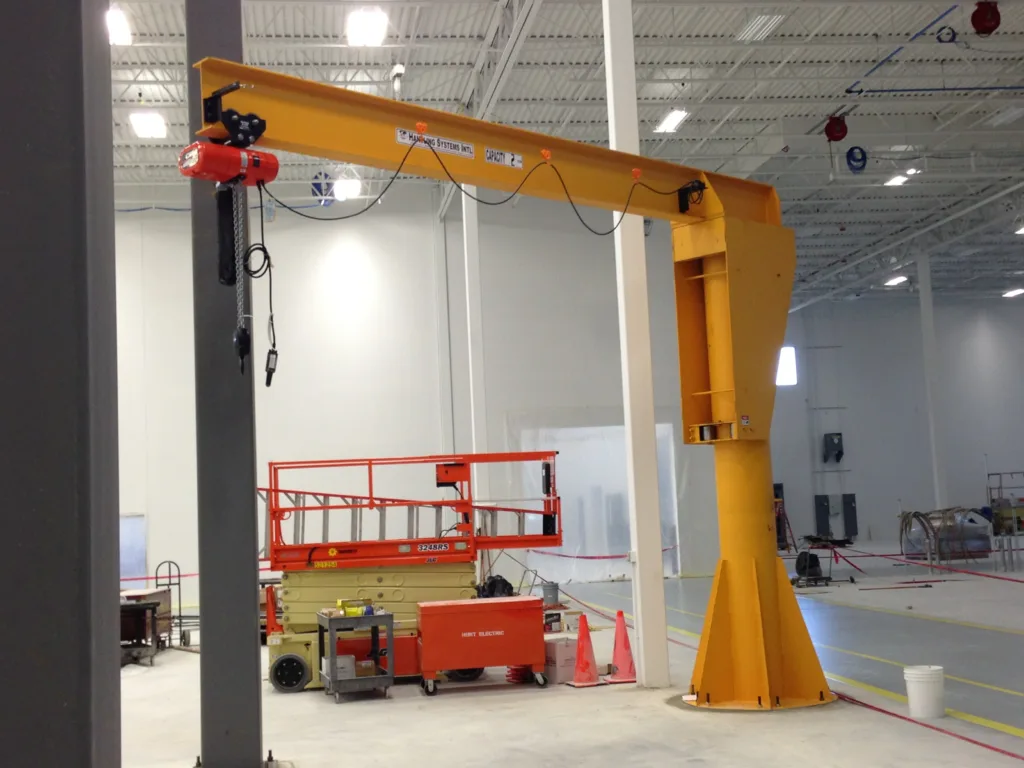At Handling Systems International (HSI), we pride ourselves on providing custom-built crane solutions to meet the unique lifting needs of our customers. Two popular types of cranes we offer are jib cranes and gantry cranes. While both serve essential roles in material handling, they have distinct characteristics and applications. Let’s explore the key differences between these two crane types.
Jib Cranes: Versatility in Confined Spaces
Jib cranes are characterized by their simple yet effective design. They consist of a horizontal boom attached to a vertical mast, allowing for rotational movement. Here are some key features of jib cranes:
- Space-saving design: Ideal for workstations and areas with limited floor space
- Versatility: Can be mounted on walls, floors, or columns
- Range of motion: Typically offers 180° to 360° rotation
- Customizable: Available in various capacities and boom lengths
Jib cranes excel in applications requiring frequent lifting within a specific work area, such as assembly lines, loading docks, or maintenance bays
Gantry Cranes: Power and Mobility Gantry cranes, on the other hand, are designed for heavy-duty lifting and broader coverage areas. They consist of a bridge supported by two or more legs that move along ground-level runways. Key features of gantry cranes include:
- High load capacity: Suitable for lifting heavy loads
- Large coverage area: Can span significant distances
- Mobility: Ability to move along tracks or rails
- Versatility: Available in various configurations (single girder, double girder, etc.)
Gantry cranes are commonly used in outdoor settings like shipyards and construction sites, as well as indoor facilities such as warehouses and manufacturing plants.
Key Differences
- Structure: Jib cranes have a boom attached to a single support, while gantry cranes have a bridge supported by multiple legs.
- Coverage area: Jib cranes cover a circular area, while gantry cranes cover a rectangular area.
- Load capacity: Gantry cranes generally have higher load capacities compared to jib cranes.
- Mobility: Jib cranes are fixed in one location (though some can be portable), while gantry cranes can move along tracks.
- Space requirements: Jib cranes are more compact, while gantry cranes require more floor space but offer greater coverage.
Choosing the Right Crane
When selecting between a jib crane and a gantry crane, consider factors such as:
- Available space
- Load capacity requirements
- Frequency of use
- Coverage area needed
- Mobility requirements
At HSI, we understand that every lifting application is unique. Our team of experts is dedicated to helping you choose the right crane solution for your specific needs. Whether you require the compact versatility of a jib crane or the robust power of a gantry crane, we have the expertise to design and manufacture a custom solution that meets your exact specifications.By understanding the differences between jib cranes and gantry cranes, you can make an informed decision that enhances your operational efficiency and safety. Trust HSI to provide you with quality-made, strong cranes that are built to last and tailored to your unique requirements.

